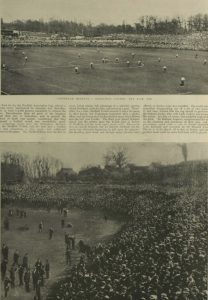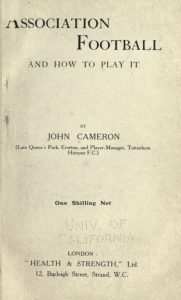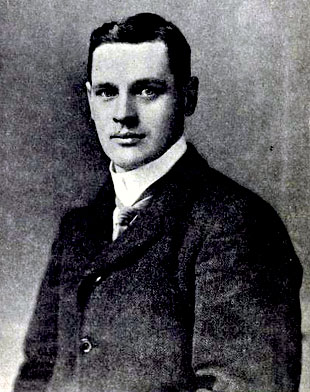JOHN CAMERON; A GREAT SPUR
BY Vince Cooper
Given that the history of Spurs is sprinkled with great Scots (think Dave Mackay, Alan Gilzean, John White etc) it is probably no surprise that the club’s first ‘great’ had his roots in Ayr.
John Cameron was born on 13th April 1872 in Ayr where his father owned a grocery shop. After attending Ayr Grammar School and playing for local team Ayr Parkhouse (who would later merge with a local rival and become Ayr United) he joined Queens Park. But he spent a single season with the (then) giants, winning what would prove to be his only cap for his country in a 3-3 draw with Ireland in Belfast while working for shipping giants Cunard in Glasgow.
Work then took him south to Merseyside and he moved to Cunard’s offices in Liverpool. According to the Everton record books, a Mr Allen received a £10 fee in relation to the move so it can be assumed that this was the man who scouted him on Everton’s behalf and helped arrange his move to the club.
This saw a move to Everton and also a switch from centre-forward to an inside-forward position. Cameron’s debut for his new club was a successful one scoring one and making two as the Toffees romped to a 5-0 win over Sheffield United.
In The Athletic News, The Loiterer was certainly impressed with the new boy’s performance. “Cameron never seemed strange in his play to his companions”, he wrote, “and the confident way he did his work was as gratifying as his cleverness in working the ball”.
The next change came when his new club persuaded Cameron to turn professional, enabling him to push the shipping career aside and devote himself full time to the game. This move came after Cameron had returned to Scotland a couple of times to play for Queens Park. The Toffees wanted Cameron’s full-time commitment and needed him to turn pro to get it, whilst the Scottish club, made up wholly of amateurs wanted him to retain his unpaid status. Everton won the day, and in doing so made him one of the highest-paid players in the game.
Cameron’s initial pay was just £3 per week ‘expenses’ while he continued to work at Cunard but this was increased to £5 and he turned pro after it was reported that West Brom were keen to sign him.
His first game as a pro came in a goalless draw with Liverpool and a week later he bagged a hat-trick in a 6-0 win over Burnley. But the Merseyside team had a wealth of forward talent at the time and the Scot wasn’t an automatic first-choice. In fact he didn’t feature at all in the 1897 F. A. Cup run which saw them reach the final before losing 3-2 to double-winners Aston Villa
In 1898 Cameron became involved in the movement for the unionisation of Footballers. This came about after Football League directors announced that they planned to impose a maximum wage of £4 per week, a decision which the Scot, somewhat understandably, was vehemently opposed to.
Thus, with the support of most of the top players of the time, the Association Footballers Union was formed at a meeting in the Bee Hotel in Liverpool with Cameron as secretary and treasurer (another Scotsman, Jack Bell also of Everton, was chairman). The Union insisted that they were not formed to focus on wage issues but on transfer negotiations with the aim being to include players in any discussions on moves rather than just the clubs involved.
Bell, along with brother Laurie was barring Cameron’s path to regular first-team football with Everton and after playing in the match against Sheffield United at Goodison on the 22nd of February 1898 he was demoted to the Second XI for whom he played in the Liverpool Senior Cup win over New Brighton Tower in what would prove to be his last appearance for the Toffees.

He then left Everton for whom he scored 12 goals in 42 games and the Football League, to join Southern League Spurs in the summer for a fee of £150. He had won his only cap for his country back in 1896, appearing in a 3-3 draw with Ireland in Belfast, although it is interesting to note that he was listed as a Queen’s Park player rather than Everton.
Cameron was brought to North London as part of a signing spree by new manager Frank Brettell who had himself only just arrived from Bolton. Within a few months of his move down from Lancashire the manager himself was on his way out after being offered a better-paid position at Portsmouth.

Tottenham Hotspur 1900
In his short time under Bettrell, Cameron impressed the directors enough that, in February 1899 he was offered the position of secretary-player-manager. In his first game in charge the team came from behind to beat the mighty Sunderland in an FA Cup tie at Northumberland Road with Cameron scoring the winner.

Spurs with the Southern League shield
The triple role didn’t seem to affect Cameron as he finished his first season at the club as top scorer with 34 goals with the team finishing 7th in the Southern League and reaching the 3rd Round of the FA Cup.
The 1899-1900 season was Cameron’s first full term in charge of Spurs and it was a momentous one both on and off the pitch.
The club left their then home at Northumberland Road home and moved a short distance, leasing land next to the White Hart pub from Charrington’s Brewery and moving the stands to their new location. A crowd of 5,000 attended the first official match at the new ground, known at that stage as ‘The High Road Ground (it wouldn’t become White Hart Lane until after WW1) a 4-1 friendly win over Notts County.
Cameron signed a number of new players and led them from the front. In his first season in charge, the team, included four Scotsman (Harry ‘Tiger’ Erentz, Sandy Tait, John Copeland and Cameron himself), Irishman Jack Kirwan and two Welshmen in centre-half Ted Hughes and experienced skipper Jack Jones from Bootle. They won their first Southern League title at just the fourth time of asking, finishing three points clear of Portsmouth.
In 1900-01 things got even better. Cameron added a fifth Scot to the line-up with what would prove to be the crucial signing of Alexander ‘Sandy’ Brown from Portsmouth. Although league form dropped off with a 5th-place finish in the Southern League it was made up for by the FA Cup exploits of this side gathered from far and wide (one fascinating fact is that not a single player from that season’s regular starting XI was born within 100 miles of White Hart Lane).
The 1st Round draw was anything but kind to Spurs as they were given the task of taking on the mighty Preston North End who had knocked them out in the previous year’s competition. After a 1-1 home draw Cameron took his team to Deepdale with fans fearing the worst but they recorded a famous 4-2 victory with the player-manager himself opening the scoring then Brown weighing in with a hat-trick.
Thing didn’t get any easier in the 2nd round with Spurs drawn to meet holders Bury. Despite the tie being at White Hart Lane Cameron’s team were underdogs with Tottenham’s hopes being described in one contemporary publication as ‘the wish being father of the thought’.
Bury took the lead after just two minutes and things looked glum for the home team but they settled down and slowly got a grip on the game. Cameron set up Brown for the equaliser and from then on Sours took charge. It came as no surprise when Brown headed the winner.
In the 3rd Round a 1-1 draw at Elm Park where the Londoners were lucky to survive after a clear penalty was not given, brought Reading back to White Hart Lane where they were comfortably seen off by a 3-0 scoreline (two of them from Brown) and this set up an Easter Monday semi-final against West Bromwich Albion at Villa Park.

The final programme
After wins over Southampton on Good Friday and Bristol City on Saturday in Southern League fixtures, Cameron took his team to Birmingham for the semi where they were initially denied entry by an ‘over-zealous guardian of the gate’. Eventually allowed in they fought an even first-half which finished goalless but took control in the second period scoring four unanswered goals, all from the prodigious Brown.
And so to the final, just 12 days after the semi, with Spurs set to face another giant of the game in the form of Sheffield United at Crystal Palace.
With the Yorkshire team on a win bonus of £10 per man and the Londoners on a hefty £25, an immense crowd officially given at the time of 111,887 watched a match full of drama and controversy.

Action from Crystal Palace
Fred Priest gave United the lead but a pair of goals from Brown (who else?) turned things around. Walter Bennett then equalised for the Blades although Cameron and his team were adamant that the ball was ‘at least two feet over the line’ and had gone out for a goal-kick before being played into the goalmouth. The score remained 2-2 despite Cameron’s men having numerous chances to get past ‘Fatty’ Foulke again. So the teams were sent north for a replay a week later.
The second match being played at Bolton’s Burnden Park home gave Spurs a big advantage according their manager.. “Playing at the Palace was difficult” he said after the first match; “owing to our inexperience of the peculiarities of the ground”.

Action from the replay
A disappointing crowd of 20,470 watched the replay (it was originally due to be played at Goodison Park but after objections by Liverpool was switched) and they saw Cameron who gave the Londoners the lead. Although Bennett equalised Spurs were always on top and goals from Tom Smith and, inevitably, Brown wrapped up the win, brought the cup back to London and took it outside the Football League.

Cameron with the Spurs board and the F. A. Cup
So the trophy came to White Hart Lane for the first time, fired by the astonishing record of that man Brown.
Alexander White Brown was born on the 21st of December 1877 and was the first football great to come from the village of Glenbuck which was later made famous as the home of the Shankly brothers. Known as ‘The Glenbuck Goalgetter’, Brown had successful spells at Portsmouth on either side of his Spurs heroics and would go on to prove a decent forward for Middlesbrough and Luton Town.

Sandy Brown
Chosen to play for his country in 1902 against England., he scored but the game was stopped after the Western Tribune Stand collapsed killing 25 spectators. They resumed but the result was later declared void. Two years later Brown, by now a Middlesbrough player, was again picked for Scotland against the ‘Auld Enemy’ but England, with his replacement Vivian Woodward at centre-forward, won 1-0 thanks to a Steve Bloomer goal.’
That proved to be the star striker’s only cap and it was his time at Tottenham and in particular the 1900-01 cup run, that he is best remembered . He scored in every round and amassed an astonishing 15 goals – a record – in the competition.
After less than two seasons with the club Brown was gone just six months after the cup success having scored 96 times in 113 games across all competitions, moving back to Fratton Park. After his spells at Middlesbrough and Luton Town and with a number of smaller clubs Brown eventually emigrated to New Zealand.
Spurs would go on to finish Southern League runners-up twice more during Cameron’s reign as manager but that 1901 campaign was clearly the zenith of his time in charge of the club. The year was also important on a personal level for the boss as he married Grace Steele in Ayr.
In 1907 after what were described as ‘various differences of opinion’ Cameron announced his resignation as manager, having already hung up his boots a couple of years before. It was initially reported that he would take over at Chelsea but negotiations fell through. Instead he worked as a football journalist for a short time before moving to Germany where he took over as manager at Dresdner SC.

‘Association Football and how to play it’
In 1908 he wrote ‘Association Football and how to play it’ which covered all aspects of the game as well as many of Cameron’s football memories and leaving for Germany he co-wrote, along with ‘Two old Spurs’ ‘The White Hart – A Souvenir of Spurs’ Entry To The English League’ which was published in 1908, and wrote a chapter in The Book of Football called ‘Tottenham Hotspur – It’s Story And Progress’.
Cameron was still working in Germany when the 1st World War broke out and he was interned at Ruhleben, a civilian detention camp near Berlin alongside Fred Pentland, Steve Bloomer and a number of other football greats. He played a major role in football at the camp and led a ‘World XI’ team that played two matches against an ‘England XI’ led by another former Spur John Brearley, who Cameron had brought to North London from Everton.
The war years were not kind to Cameron. Not only was he interned miles from home but also his wife passed away in 1915.
When he was eventually repatriated Cameron returned to Scotland and took over as manager of Ayr United but he spent only a year at the club before resigning saying that he had not fully recovered from his internment.
He worked as a clerk and also carried on as a respected writer until his death at the age of 63 in 1935.
As a player John Cameron was described as a ‘truly classy inside-forward’ and that solitary cap for Scotland would seem scant reward for a player of his class, although he played mostly in England at a time when the Scottish selectors rarely chose ‘Anglos’ to play. As player-manager and later manager he led Tottenham to their first major honour and signed a number of top players for the club, keeping them at the highest level throughout his time in charge.
In his article for ‘The Book of Football’ Cameron wrote; ‘May one not say without the slightest suspicion of egotism that no club has left a mark upon football in the South of England as the Tottenham Hotspur?’. Despite that lack of egotism, there is little doubt that one of the major factors in this being true was the influence of Cameron himself.

